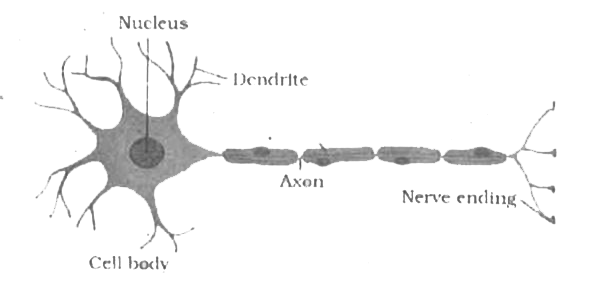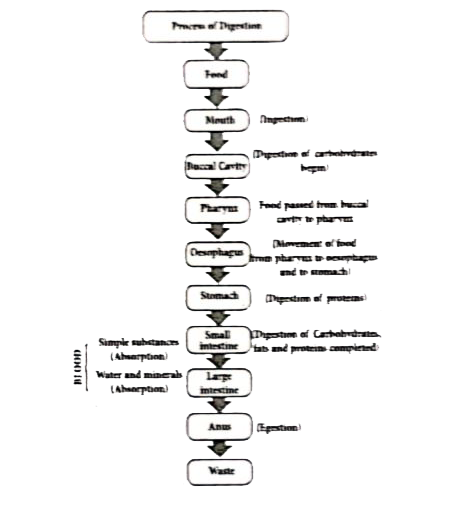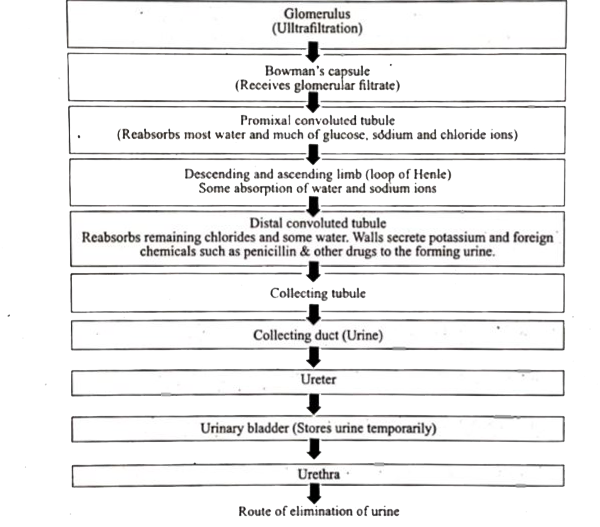Saved Bookmarks
Explore topic-wise InterviewSolutions in .
This section includes InterviewSolutions, each offering curated multiple-choice questions to sharpen your knowledge and support exam preparation. Choose a topic below to get started.
| 751. |
Question : Give scientific reasons for the statements : It is necessary to give scientific names to the organisms. |
| Answer» Solution : To identify each of the organisms of the living world and to study them WELL, it is always necessary to know each of them by its unique, definite name. The common local name are DIFFERENT for a particular organism in different regions of the world. It should be such a name that can be acceptable to the common people as well as to the scientific world. Such a name can be only a scientific name. HENCE, it is necessary to give scientific names to the organisms. This is done as per BINOMIAL nomenclature SYSTEM. | |
| 752. |
Question : Name two breeds of cattle which are selected for their long lactation period. |
| Answer» Solution :Jersey and Brown Swiss are TWO BREEDS of cattle which are SELECTED for their long LACTATION PERIOD. | |
| 753. |
Question : Name three cell constituents of an animal of plant cells which are bounded by double unit membrances. |
| Answer» SOLUTION :NUCLEUS, MITOCHONDRIA, PLASTIDS. | |
| 754. |
Question : Give scientific reasons for the statements : Lichens are symbiotic type of organisms. |
| Answer» Solution : Some of the species of fungi and some algae or blue-green algae live in close association with each other permanently as if a single organism. They live together and benefit each other. The algal component synthesizes food by photosynthesis and provides it to the FUNGUS. The mycelium formed by the hyphae of fungus provides support, protection against STRONG sunlight and absorbs MOISTURE for the benefit of the alga. Thus they live together for mutual benefit, a mode of life, CALLED SYMBIOSIS. Hence, the lichens are called symbiotic type of organisms. | |
| 755. |
Question : Name the types of teeth present in an adult human being. Mention the functions of each. |
|
Answer» SOLUTION :Types of teeth and their functions `{:("Types of teeth","Functions"),("INCISORS","Cutting and biting"),("CANINES","TEARING and piercing"),("PREMOLARS","Crushing and grinding"),("Molars","Crushing, grinding and mastication"):}` |
|
| 756. |
Question : Give scientific reasons for the statements : In Whittaker's five kingdom classification, the fungi are shown separately from Protista. |
| Answer» Solution :In five kingdom classification PROPOSED by Whittaker, in kingdom Protista many kinds of unicellular eukaryotic organisms are INCLUDED. The animals of this kingdom can be autotrophs or heterotrophs, with or WITHOUT cell wall.The organisms of kingdom Fungi are saprophytic organisms. Many of them are MULTICELLULAR organisms. They have cell wall made of chitin. HENCE, in Whittaker.s five kingdom classification, the fungi are shown separately from Protista. | |
| 757. |
Question : Name the type of nutrition in fungi. |
| Answer» SOLUTION :Fungi are the HETEROTROPHIC eukaryotic ORGANISMS having SAPROTROPHIC or SAPROPHYTIC mode of nutrition. | |
| 758. |
Question : Give scientific reasons for the statements : Crocodile and turtle can live on the land as well as in water. Yet they are not amphibians. |
| Answer» Solution :Amphibians pass their early life (from fertilization to just REACHING the adult STAGE) in water and never on land. Crocodile and turtle live in water, do not breed and fertilize in water, but always on the land. Secondly, amphibians can and do respire through their THIN, moist skin DEVOID of any type of exoskeleton. Crocodile and turtle have quite thick skin, not suitable for respiration. Therefore though these animals live both on the land as well as in water, they are not amphibians, but are reptiles. | |
| 759. |
Question : Name the type of diseases that occur since birth. |
| Answer» SOLUTION :CONGENITAL DISEASES. | |
| 760. |
Question : Give scientific reasons for the statements : Classification of living organisms is necessary. |
| Answer» Solution :The scientific method of dividing organisms into smaller or larger groups by taking into consideration their similarities and dissimilarities and diversities at various levels of their organization is known as classification, IMPORTANCE :(1) The study of various types of organisms becomes simple and easy. (2) The interrelationships of organisms can be known. (3) It provides FUNDAMENTAL information for various branches of biology, such as ecology biogeography and behavioural science. (4) Some of the fields of applied biology, such as AGRICULTURE, social health, etc. are based on the information of classification. (5) We can visualize the pictures of biological forms before planning, through classification. (6) There are innumerable organisms existing on the SURFACE of the globe. It is impossible to study each of them individually Hence for convinient study and identification, taking into account, the base of their various STRUCTURAL levels, it is necessary to divide (classify) them into systematic groups. | |
| 761. |
Question : Name the two types of endoplasmic reticulum. |
| Answer» Solution :The rough endoplasmic RETICULUM and smooth endoplasmic reticulum are the two TYPES of ER. RER possesses ribosomes WHEREAS SER do not have ribosomes ATTACHED to its MEMBRANE. | |
| 762. |
Question : Give scientific reasons for the statements : Bat is not a bird and whale is not a fish. |
| Answer» Solution : Bat is a flying mammal. It has exoskeleton of HAIR and not feathers. The external ear shows pinna, the codont teeth in the jaws. Wings are not provided with feathers and it is viviparous, giving BIRTH to living young ones. Hence, the bat is not a BIRD. Whale is an aquatic mammal. It does not have exoskeleton of DERMAL scales but has hair on the skin. Its heart is four-chambered. It is a warm-blooded (homoiothermic) animal. It is a viviparous animal. Hence, the whale is not a fish. | |
| 763. |
Question : Name the two phases in the life cycle of poultry. |
|
Answer» |
|
| 764. |
Question : Give scientific reasons for the statements : All vertebrates are chordates but all chordates are not vertebrates. |
| Answer» Solution :All the vertebrates have a BACKBONE called vertebral column on the dorsal side in the body. The vertebral column develops by the transformation of NOTOCHORD. Thus, notochord is a must for the formation of vertebral column. HENCE, all the vertebrates are BASICALLY CHORDATES. | |
| 765. |
Question : Which tissue makes up the husk of a coconut? |
| Answer» SOLUTION :SCLERENCHYMA | |
| 766. |
Question : Give scientific reasons for the statements : Amphibians lay eggs in water. |
| Answer» Solution :Amphibians have a larval stage called tadpole. It is aquatic and respires with the help of GILLS. The eggs hatch into these larvae and larvae LATER metamorphose into adult frog. For this development water is needed THEREFORE, amphibians LAY eggs in water. | |
| 767. |
Question : Name the three varieties of pesticides used. Write the problems related to excess use of pesticides. |
|
Answer» Solution :Three varieties of pesticides are herbicides, fungicides and insecticides. The problems related to excess use of pesticides are as follows: 1. They can be sprayed in excess and REMAIN accumulated in the environment causing environmental pollution. 2. With some pesticides, the beneficial life forms may also be terminated. 3. The pesticides may act as poison forhuman beings too and thus cause hazard to the health of the farmers. 4. Many pesticides remain accumulated in the bodies of organisms and they to on INCREASING in their concentration as PER the FOOD chain. This is called biomagnification which is very harmful. |
|
| 768. |
Question : Give reasons why mitochondria are called 'power houses' and ATP as 'energy currency' of the cell. |
| Answer» Solution :Mitochondria us molecular OXYGEN and bring about stepwise oxidation of food stuffs (carbohydrates, fats, proteins) present in the cells to produce carbon dioxide and water. Oxidation of food releases energy which is temporarily stored to FORM high-energy ATP MOLECULES. ATP is USED to bring about energy-requiring activities of the cell. On this account, mitochondria are CALLED 'power houses' of the cell and ATP as the 'energy currency' of the cell. | |
| 769. |
Question : Name the three most important mineral elements required for plant growth. |
|
Answer» |
|
| 770. |
Question : Give reasons why the meristematic cells have a large nucleus and dense cytoplasm. |
| Answer» SOLUTION :Menstematic cells are continously dividing cells so they have a prominent nucleus and dense cytoplasm But SINCE these cells do not STORE food or waste MATERIAL, they lack vacuole. | |
| 772. |
Question : Give reasons for the following : (a) Bacteria are prokaryotic cells. (b) Mitochondria are also called semiautonomous organelles. |
|
Answer» Solution :(a) (i) Bacterial cells have nuclear material not bounded by nuclear membrane. (ii) Bacteria LACK membrane-bound cell organelles such as mitochondria, ER, Golgiapparatus, lysosomes, vacuoles ETC. (B) Mitochondria have DNA, RNA, RIBOSOMES and enzymes. These can synthesize some of their proteins. HENCE, these are termed semiautonomous organelles. |
|
| 773. |
Question : Name the term used for the genetic material which lies in direct contact with the cytoplasm in prokaryotes. |
|
Answer» |
|
| 774. |
Question : Give one point of difference between notochord and nerve cord. |
|
Answer» |
|
| 776. |
Question : Give one example of solid and one of liquid fumigant. |
|
Answer» |
|
| 777. |
Question : Name the stain used to stain onion peel and human cheek cell. |
| Answer» SOLUTION :The STAIN USED for STAINING ONION peel is safranin. The stain used for staining human cheek cells is methylene blue. | |
| 778. |
Question : Give one example of natural insecticide. |
|
Answer» |
|
| 779. |
Question : Name the source of illumination in electron microscope. |
|
Answer» |
|
| 780. |
Question : Give one example of hemichordata, urochordata and cephalochordata. |
|
Answer» (II) Urochordata - HERDMANIA (III) CEPHALOCHORDATA - Amphioxus (BRANCHIOSTOMA) |
|
| 781. |
Question : Name the single-celled marine alga which is about 10 cm long. |
|
Answer» |
|
| 782. |
Question : Give notes on: (i) squamous epithelium, (ii) cuboidal epithelium, (iii)columnar epithelium (iv) ciliated epithelium and (v) glandular epithelium. |
|
Answer» Solution :(i) Squamous Epithelium is made up of thin flat cells with prominent nuclei. It forms delicate lining of the buccal cavity alveoli of lungs, proximal tubule of kidneys blood vessels and covering of the skin and tongue. It protects the body from mechanical injury. drying and invasion of germs. it also helps in FILTRATION by forming a selectively permeable membrane surface. (ii) Cuboidal Epithelium is composed of single layer of cubical cells. The nucleus is round and lies in the centre. this tissue is present in the thyroid vesicles. salivary glandsswear glands and exocrine pancrease. It is also found in the intestine and tubular part of the nephron as MICROVILLI that INCREASE the absorptive surface area. their main function is SECRETION and absorption (iii) Columnar Epithelium is composed of a singlre layer of slender elongatedand pillar like cells, Their nuclei are LOCATED at the base. it is found lining the stomach, gall bladder, bile duct, small intestine, colon, ovidu t and also forms the mucous membrane. They are mainly involved in secretion and absorption. |
|
| 783. |
Question : Name the scientists who proposed cell theory. Who gave the idea that the cells arise from pre-existing cells. |
| Answer» Solution :Schleiden (1838) and Schwann (1839) : RUDOLF VIRCHOW (1855). | |
| 784. |
Question : Give examples for the following : (a) ………… are known to have pseudocoelom (b) Worm causing elephantiasis is ……….. (c) Bilateral, dorsiventral symmetry is found in ………… (d) Open circulatory system is found in ………. |
|
Answer» (b) Wuchereria or FILARIA , (c) LIVER fluke/Frog/Lizard (d) Arthropoda. |
|
| 785. |
Question : Name the scientist who presented the cell theory. |
|
Answer» |
|
| 786. |
Question : Draw a labelled diagram of a neuron |
Answer» SOLUTION :
|
|
| 788. |
Question : ................ are the enzymes involved in the breakdown of fats in the small intestine during the process of digestion . |
Answer» SOLUTION :
|
|
| 789. |
Question : Name the regions, in which parenchyma tissue is present. |
| Answer» SOLUTION :Leaves FRUITS and FLOWERS are the regions where the parenchyma TISSUE is present. | |
| 790. |
Question : Draw a flow chart showing the route of urine flow. |
Answer» SOLUTION :
|
|
| 791. |
Question : Name the processes that help water absorbed by the roots to reach the leaves |
|
Answer» |
|
| 792. |
Question : Draw a chart showing classification of plants |
Answer» SOLUTION :
|
|
| 793. |
Question : Name the processes that help water absorbed by the roots to reach the leaves. |
|
Answer» |
|
| 794. |
Question :Name the process by which CO_(2) and water (H_(2)O) move in and out of the cell. |
| Answer» Solution :`CO_(2)` MOVES in and out of the CELL by diffusion while the water moves in and out of the cell by OSMOSIS. | |
| 795. |
Question : Draw a chart showing five kingdom classification method |
Answer» SOLUTION :
|
|
| 796. |
Question : Name the plant part (a) Which bends in the direction of gravity but away from the light. (b) Which bends towards light but away from the force of gravity. |
|
Answer» SOLUTION :(a) ROOT (B) STEM. |
|
| 797. |
Question : Draw a chart showing classification of animals |
Answer» SOLUTION :
|
|
| 798. |
Question : Name the part of plant which shows positive geotropism. Why? |
| Answer» SOLUTION :Root SHOWS POSITIVE geotropism because of the unidirectional movement in response to gravity. | |
| 799. |
Question :Does Desi cow look like a Jersey cow? |
| Answer» SOLUTION :DESI COWS and JERSEY cows are not SIMILAR to each other. | |
| 800. |
Question : Name the organs affected due to the following diseases :Malaria, Jaundice, Japanese encephalitis, typhoid. |
| Answer» Solution :1. Malaria : INFECTS LIVER and RED blood cells 2. Infects the liver : Jaundice 3.Japanese encephalitis : Infects the brain 4. Typhoid : Infected blood. | |